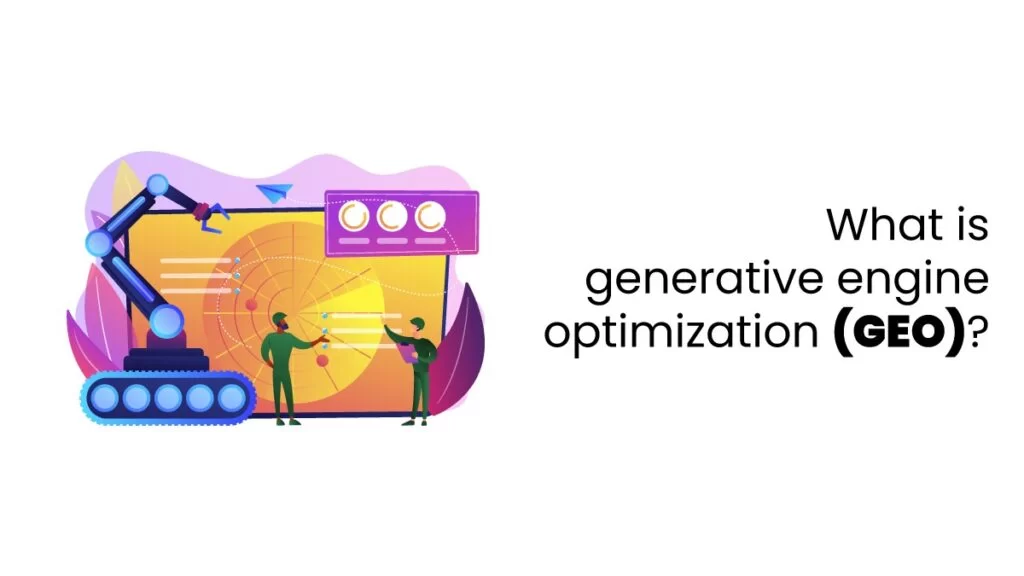Introduction
In the fast-evolving world of digital marketing, Generative Engine Optimization (GEO) is emerging as a powerful strategy to stay ahead. Search engines are getting smarter with AI, giving more conversational answers. So, doing old-school SEO just isn’t going to cut it anymore. That’s where generative engine optimization steps in—It’s not just about getting your content to show up on regular search results anymore; you need to make it work well with AI search too. But what is generative engine optimization, exactly? It’s all about making content that works well with how AI understands, suggests, and shows information. If you’re looking to stay competitive or even lead in this space, learning GEO through the best SEO course available can give you a serious edge.
GEO in a Nutshell
Generative Engine Optimisation (GEO) is about making your content easy for AI search engines to understand. It’s different from regular SEO, which tries to get your website to rank high on search results pages. GEO wants AI to find and use your content easily. Things like writing clearly, guessing what people will ask, and organizing your information well can support this. Basically, GEO helps people see your work when machines read data before humans do.
Why GEO Matters Now
The way people search online changes all the time, and so does the tech that powers it. Now, we have AI chatbots and tools that give you answers directly in a chat, instead of just a list of links. This means if you make content or do marketing, you have to change the way you do things. GEO is important at the moment because it makes your content fit how AI understands and gives out information. It’s not only about ranking high in search results anymore; it’s about being the actual answer that people see. If your content isn’t GEO-ready, people might not see it where they usually look for information.
The Shift to AI Search
Search engines have changed a lot. Instead of just listing links, they now use AI to give you answers, summaries, and suggestions. This switch to AI search means bots read and share content before people do. If you want your content to be seen, write it so AI can easily understand it. Make it clear, structured, and focused on what people are really asking. It’s a big change, but it’s also a chance to do things differently and get ahead.
SEO vs GEO Basics
Traditional SEO is all about making your website show up higher in search results, like on Google. To do this, you use keywords, get links from other sites, and tweak things like meta tags and the content on your pages. Basically, you want to understand what Google looks for and make your site fit those rules so people click on it.
Now, there’s GEO (Generative Engine Optimisation), which is made for the new AI search tools. Instead of just getting your site to show up in search results, GEO helps make sure AI systems understand your content and pick it—sort of like how chatbots or voice assistants work. It’s more about talking to the AI, understanding what people want, and making sure things are easy for machines to read. Basically, SEO helps you get noticed on search engines, while GEO helps AI find you.
How GEO Works
Generative Engine Optimisation is all about making your content easy for AI to understand. Instead of just throwing in keywords or trying to get a bunch of links, you focus on being clear, giving context, and being helpful. AI checks content for good answers, natural language, and if it’s related to what people are asking. So, write like you’re helping someone out – answer questions directly, use simple words, and keep things organized so everyone gets it. If AI gets your content, it’s more likely to use it when it makes responses.

GEO and Content Creation
Generative Engine Optimisation is totally shaking up content creation. Forget just writing for people; now you’re writing for the AI that spits out instant answers. To get GEO right, content should be on point. Think clear headings, straight answers, and a conversational tone. Instead of walls of text stuffed with keywords, break things down. Use short, question-based formats that AI can easily grab and reuse. Basically, GEO pushes for smarter, more focused content. This way, search engines and the people searching get what they need.
Getting Found in AI Results
Now that we have generative search, it’s not just about being at the top of the search results anymore. It’s about being the go-to source for answers. To get noticed, your content should be clear and focus on what people are really looking for. Consider how people ask questions in everyday speech and write content that straightforwardly answers those questions. Make sure to provide the right context and cover topics well. If your content is valuable, AI tools are more likely to pick it up for responses.
Structuring for AI Readability
AI tools don’t read content like humans—they scan for patterns, structure, and clearly labelled sections. That’s why a clean layout is key. Break up your content with clear subheadings, keep paragraphs short, and highlight key points using bullet lists or numbered steps. This formatting helps AI easily identify where answers begin and end, making your content more likely to be quoted or summarised in AI-generated results.
Think of it like designing your page for a robot to read at lightning speed. Avoid walls of text or sections that try to cover too much at once. Stick to one idea per section and use consistent formatting styles. Even small things, like using bold for important terms or adding quick summaries, can signal to AI that your content is well-organised and reliable. A simple structure doesn’t just help machines—it creates a better experience for readers, too.
Authority and Trust Signals
To grab the attention of those AI content tools, just having good content isn’t the whole story. You also need to come across as a source folks can count on. AI looks for things that seem legit, steady, and based on actual know-how. So, make it clear who’s making the content, keep it current, and back up what you say with real information. Even simple stuff like a quick bio or sounding professional can really help build trust with readers and the AI that’s grabbing your content.
Building authority takes time; it comes from being consistent and having a solid reputation. If your site often shares helpful information, other reliable sites link to you, or you’re mentioned online, AI notices. It’s like growing your online rep: the more your content is seen as helpful and correct, the more likely AI will use it in its answers. In a world where machines pick what people see, trust comes from both readers and the algorithms.
What AI Looks For
Generative AI goes beyond just picking out simple keywords. It really gets into what the user is looking for. That’s why content that reflects what people want to know does better. AI aims to match questions with relevant, informative answers. If your content can address questions before they’re even asked or flow into related topics smoothly, it’s more likely to be picked. So, instead of just worrying about phrases, think about what people really want when they search and craft your message to meet that need.
Another thing AI checks is how well your content ties everything together. Is your answer thorough? Does it help users understand, solve a problem, or take the next step? These tools are there to find content that feels genuine and useful, not robotic or vague. If you put real effort into your writing to inform, it will stand out. In the world of GEO, grasping why someone is asking something matters just as much as giving the right answer.
Optimising for Conversations
Writing for conversations means creating content that sounds like a real person explaining something in a simple, friendly manner. Instead of just focusing on keywords or confusing technical terms, the point is to answer questions as if you were chatting with someone. If your writing feels natural and flows well, it’s more useful for readers, and it’s also better for AI tools that find answers from different places.
This way of writing is really important now that we have generative AI. People are asking full questions instead of short keywords. AI search engines want to give answers that sound human and make sense. So, the more your content sounds like a conversation, the more likely it is to be used in AI responses. Basically, write like you’re talking to a person, not just trying to impress a computer.
Real Examples of GEO
As AI tools like Chatgpt, Google’s SGE, and Perplexity change how people search for information, making your content suitable for these engines is more important than ever. For example, sites like Wikipedia and Healthline often pop up in AI answers. They use simple formatting, easy headers, and get straight to the point, which helps AI understand and share their content.
Consider asking an AI for recommendations on the best smartphones or tips on how to be more productive. It usually grabs information from sites like TechRadar, Wirecutter, or CNET. These sites have clear reviews that list both the good and bad points, making it easy to compare items. Even good blog posts with FAQs or easy-to-understand guides (like the ones from Neil Patel or Moz) are used by AI to give answers. These sites do well because they’re clear, trustworthy, and answer real questions in a simple way that anyone can understand.
Tools That Support GEO
If you want your content to do well with AI, focus on making it clear, well-organised, and relevant. Surfer SEO is a great tool; it helps you create content using actual search data. It shows you what keywords and headings are used in top-ranking content, which can make your writing more AI-friendly.
Frase is another good choice. It helps you create content around the questions people actually ask online. Since AI likes grabbing answers from conversational content, this can be a big plus. ClearScope and MarketMuse also help make your content more relevant and informative, which means it’s likely to get picked up by AI search tools. Even a simple tool like Grammarly can assist because it makes sure your writing is clear and easy to read.
The Future of GEO
Online search is changing fast, and Generative Engine Optimisation (GEO) is a big part of that. With tools like Chatgpt, Google SGE, and Perplexity getting more popular, people ask questions fully and want quick, human-sounding answers. So, it’s not just putting the right keywords but making content sound real, answer questions, and feel like a conversation. If your content sounds like something you’d say, that’s good.
Soon, GEO will change how content creators and businesses work. Instead of working to be on the first page of Google, the point is to be the source AI tools trust and use. That’s big. The content that does well will be simple, organised, and actually helpful. If you’re writing blogs, product descriptions, or FAQs, consider how it sounds, not just how it ranks. The more human your content sounds, the more it’ll show up in AI answers.
Conclusion
If you’ve been asking yourself what is generative engine optimization, it’s all about creating content that AI tools can easily understand and share with users. Instead of just focusing on search rankings, the goal is to write clearly, answer real questions, and sound like a human—not a robot.
As AI continues to shape how people find information online, generative engine optimization will play a bigger role in content strategy. The more helpful, natural, and trustworthy your content is, the better chance it has of being used by AI tools. It’s a smart way to stay visible in a fast-changing digital world.










